Global Natural Language Processing Market, By Offering, By Deployment, By Application, By Organization Size, By End Use Industry, By Region & Segmental Insights Trends and Forecast, 2024 – 2034
- Industry: Technology
- Report ID: TNR-110-1124
- Number of Pages: 420
- Table/Charts : Yes
- June, 2024
- Base Year : 2024
- No. of Companies : 10+
- No. of Countries : 29
- Views : 10230
- Covid Impact Covered: Yes
- War Impact Covered: Yes
- Formats : PDF, Excel, PPT
Natural Language Processing (NLP) is a field of artificial intelligence focused on enabling computers to understand, interpret, and respond to human language. Current trends in NLP include advancements in deep learning, transformer models like GPT and BERT, and real-time language translation. Key opportunities lie in healthcare (automated diagnostics), finance (fraud detection), and customer service (enhanced chatbots). Growth drivers for the NLP market include increasing demand for big data analytics, rising adoption of smart devices, and the need for effective sentiment analysis in social media and market research. The expansion of e-commerce and the globalization of businesses also contribute to the demand for NLP technologies to bridge language barriers and improve customer interactions.
In Terms of Revenue, the Global Natural Language Processing Market was Worth US$ 17.5 Bn in 2023, Anticipated to Witness CAGR of 32.7% During 2024 – 2034.
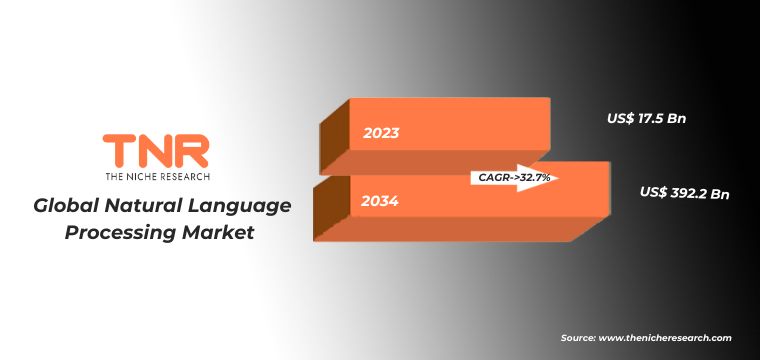
Trends in the Global Natural Language Processing Market
- Advancements in Transformer Models: The development and adoption of transformer models like GPT-3 and BERT have revolutionized NLP. These models enable more accurate and context-aware language understanding and generation. They are being increasingly used in applications such as chatbots, virtual assistants, and automated content creation. Companies are investing heavily in fine-tuning these models for specific industry needs, leading to more sophisticated and reliable NLP solutions. This trend is pushing the boundaries of what NLP can achieve, making it possible to handle more complex tasks like nuanced sentiment analysis and real-time language translation.
- Integration of NLP with Big Data Analytics: NLP’s integration with big data analytics is another significant trend. As organizations generate vast amounts of unstructured text data from sources like social media, customer reviews, and internal documents, the need to extract actionable insights from this data grows. NLP techniques are being used to process and analyze this data, enabling better decision-making and strategic planning. This trend is particularly prominent in sectors such as finance, healthcare, and retail, where understanding customer sentiment, predicting market trends, and improving operational efficiencies are crucial for maintaining a competitive edge.
Software and solutions in the natural language processing (NLP) market have emerged as a dominant force, capturing a significant revenue share of 58.5%. This dominance is driven by the rising demand for advanced NLP applications like chatbots, sentiment analysis, and language translation tools across various industries. Businesses are increasingly adopting NLP software to enhance customer experience, streamline operations, and gain insights from vast amounts of unstructured data. The continuous advancements in AI and machine learning further boost the capabilities of NLP solutions, making them indispensable in sectors such as healthcare, finance, and e-commerce, where efficient and accurate language processing is crucial.
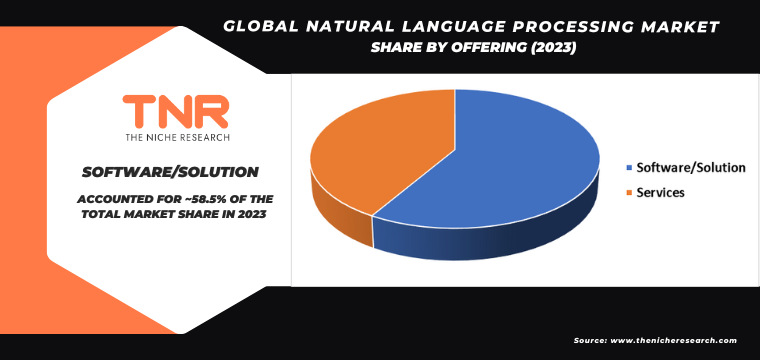
In 2023, the on-premises segment secured its position as the second-largest category in the global natural language processing (NLP) market. This growth is attributed to businesses prioritizing data security and control over sensitive information. On-premises deployment allows organizations to maintain strict compliance with regulatory requirements and internal policies, especially in sectors like finance, healthcare, and government. Despite the increasing popularity of cloud-based solutions, the need for robust security measures and the desire to manage and customize NLP applications internally have driven the demand for on-premises NLP solutions, ensuring their continued relevance and substantial market share.
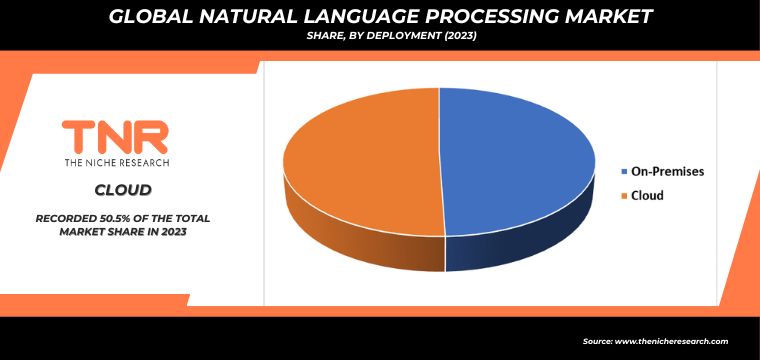
The speech recognition segment, categorized by application, has exerted significant dominance over the global natural language processing (NLP) market. This is driven by the widespread adoption of voice-activated technologies in various devices, including smartphones, smart speakers, and automotive systems. Companies like Apple, Google, and Amazon have integrated advanced speech recognition into their products, enhancing user experience and accessibility. The technology is also pivotal in healthcare for transcribing medical records and in customer service for automated call handling. Its ability to improve efficiency and convenience in both personal and professional settings underpin its dominant position in the NLP market.
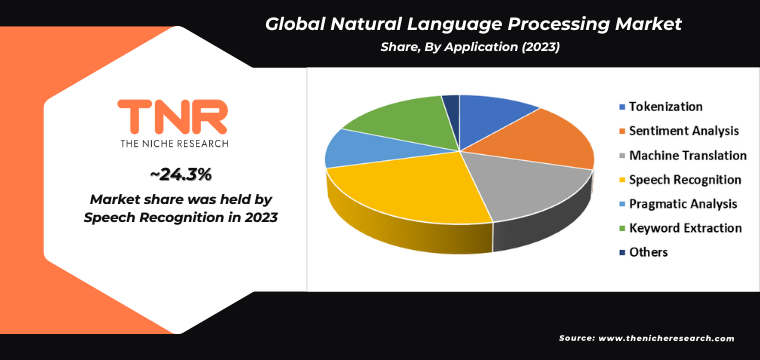
Small and medium-sized enterprises (SMEs) are projected to grow the fastest in the global natural language processing (NLP) market, with a revenue share of 46.4%. This rapid growth is fueled by SMEs increasingly adopting NLP solutions to enhance customer engagement, streamline operations, and gain competitive advantages. NLP technologies, such as chatbots, sentiment analysis, and automated customer support, offer cost-effective ways for SMEs to improve service delivery and operational efficiency. Additionally, the availability of scalable cloud-based NLP solutions makes advanced language processing tools accessible to smaller businesses, driving their adoption and contributing to their significant market growth.
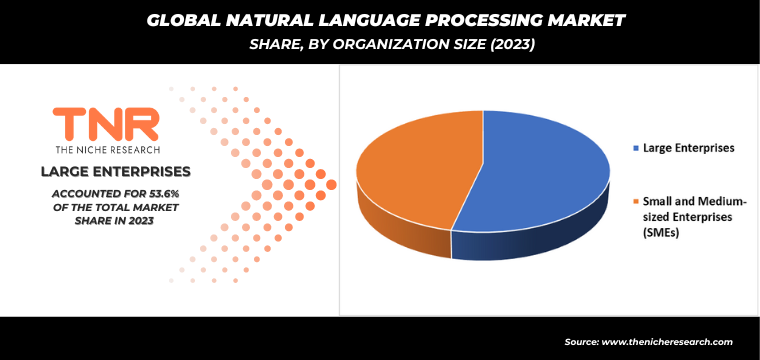
In 2023, the banking, financial services, and insurance (BFSI) segment dominated the global natural language processing (NLP) market. This dominance is driven by the sector’s need for advanced data analysis, customer service automation, and fraud detection capabilities. NLP applications, such as chatbots for customer support, sentiment analysis for market trends, and automated processing of financial documents, enhance operational efficiency and customer experience. The BFSI industry’s focus on leveraging big data for strategic insights and improving compliance with regulatory requirements has further propelled the adoption of NLP technologies, solidifying its leading position in the market.
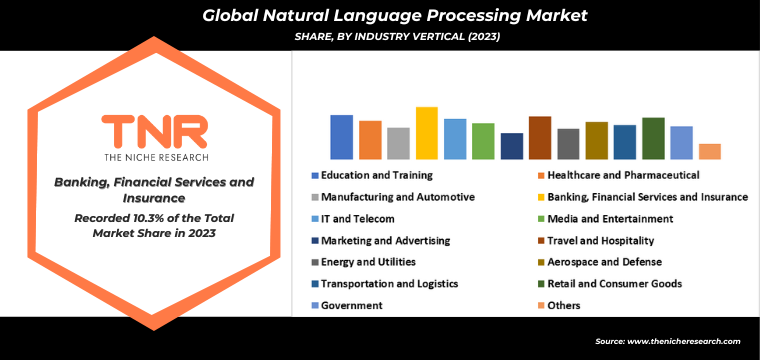
In 2023, North America solidified its dominance in the global natural language processing (NLP) market, emerging as a key powerhouse driving industry growth and innovation. This leadership is attributed to the region’s advanced technological infrastructure, significant investment in AI research, and the presence of major tech companies like Google, Microsoft, and IBM. North America’s robust ecosystem fosters continuous advancements in NLP applications across various sectors, including healthcare, finance, and customer service. Additionally, strong government support for AI initiatives and the widespread adoption of smart devices further bolsters the region’s pre-eminence in the NLP market, fueling both innovation and market expansion.
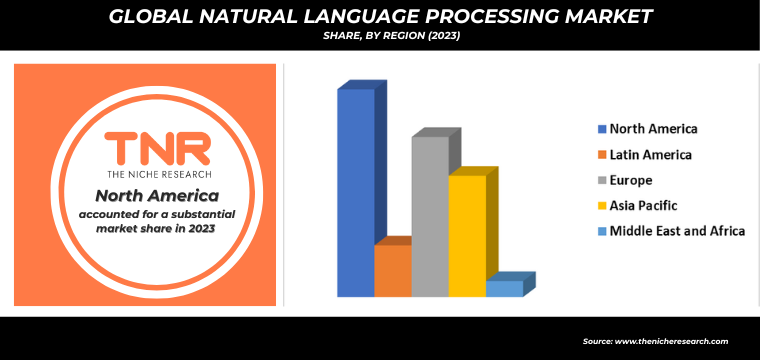
Competitive Landscape
Some of the players operating in the natural language processing market are
- Amazon Web Services, Inc
- Google, Inc
- Hewlett Packard Enterprise Development LP
- IBM
- Inbenta Holdings Inc.
- Intel Corporation
- Meta
- Microsoft
- Oracle
- SAP SE
- SAS Institute Inc.
- Veritone Inc.
- Voice AI Pty Ltd.
- Other Industry Participants
Global Natural Language Processing Market Scope
| Report Specifications | Details |
| Market Revenue in 2023 | US$ 17.5 Bn |
| Market Size Forecast by 2034 | US$ 392.2 Bn |
| Growth Rate (CAGR) | 32.7% |
| Historic Data | 2016 – 2022 |
| Base Year for Estimation | 2023 |
| Forecast Period | 2024 – 2034 |
| Report Inclusions | Market Size & Estimates, Market Dynamics, Competitive Scenario, Trends, Growth Factors, Market Determinants, Key Investment Segmentation, Product/Service/Solutions Benchmarking |
| Segments Covered | By Offering, By Deployment, By Application, By Organization Size, By End Use Industry, By Region |
| Regions Covered | North America, Europe, Asia Pacific, Middle East & Africa, Latin America |
| Countries Covered | U.S., Canada, Mexico, Rest of North America, France, The UK, Spain, Germany, Italy, Nordic Countries (Denmark, Finland, Iceland, Sweden, Norway), Benelux Union (Belgium, The Netherlands, Luxembourg), Rest of Europe, China, Japan, India, New Zealand, Australia, South Korea, Southeast Asia (Indonesia, Thailand, Malaysia, Singapore, Rest of Southeast Asia), Rest of Asia Pacific, Saudi Arabia, UAE, Egypt, Kuwait, South Africa, Rest of Middle East & Africa, Brazil, Argentina, Rest of Latin America |
| Key Players | Amazon Web Services, Inc, Google, Inc, Hewlett Packard Enterprise Development LP, IBM, Inbenta Holdings Inc., Intel Corporation, Meta, Microsoft, Oracle, SAP SE, SAS Institute Inc., Veritone Inc., Voice AI Pty Ltd., Other Industry Participants |
| Customization Scope | Customization allows for the inclusion/modification of content pertaining to geographical regions, countries, and specific market segments. |
| Pricing & Procurement Options | Explore purchase options tailored to your specific research requirements |
| Contact Details | Consult With Our Expert
Japan (Toll-Free): +81 663-386-8111 South Korea (Toll-Free): +82-808- 703-126 Saudi Arabia (Toll-Free): +966 800-850-1643 United Kingdom: +44 753-710-5080 United States: +1 302-232-5106 E-mail: askanexpert@thenicheresearch.com
|
Global Natural Language Processing Market
By Offering
- Software/Solution
- Services
- Training and Consulting
- Implementation and Maintenance
- Design and Development
- Others
By Deployment
- On-Premises
- Cloud
By Application
- Tokenization
- Sentiment Analysis
- Machine Translation
- Speech Recognition
- Pragmatic Analysis
- Keyword Extraction
- Others
By Organization Size
- Large Enterprises
- Small and Medium-sized Enterprises (SMEs)
By End Use Industry
- Education and Training
- Healthcare and Pharmaceutical
- Manufacturing and Automotive
- Banking, Financial Services and Insurance
- IT and Telecom
- Media and Entertainment
- Marketing and Advertising
- Travel and Hospitality
- Energy and Utilities
- Aerospace and Defense
- Transportation and Logistics
- Retail and Consumer Goods
- Government
- Others
By Region
- North America (U.S., Canada, Mexico, Rest of North America)
- Europe (France, The UK, Spain, Germany, Italy, Nordic Countries (Denmark, Finland, Iceland, Sweden, Norway), Benelux Union (Belgium, The Netherlands, Luxembourg), Rest of Europe)
- Asia Pacific (China, Japan, India, New Zealand, Australia, South Korea, Southeast Asia (Indonesia, Thailand, Malaysia, Singapore, Rest of Southeast Asia), Rest of Asia Pacific)
- Middle East & Africa (Saudi Arabia, UAE, Egypt, Kuwait, South Africa, Rest of Middle East & Africa)
- Latin America (Brazil, Argentina, Rest of Latin America)
Report Layout:
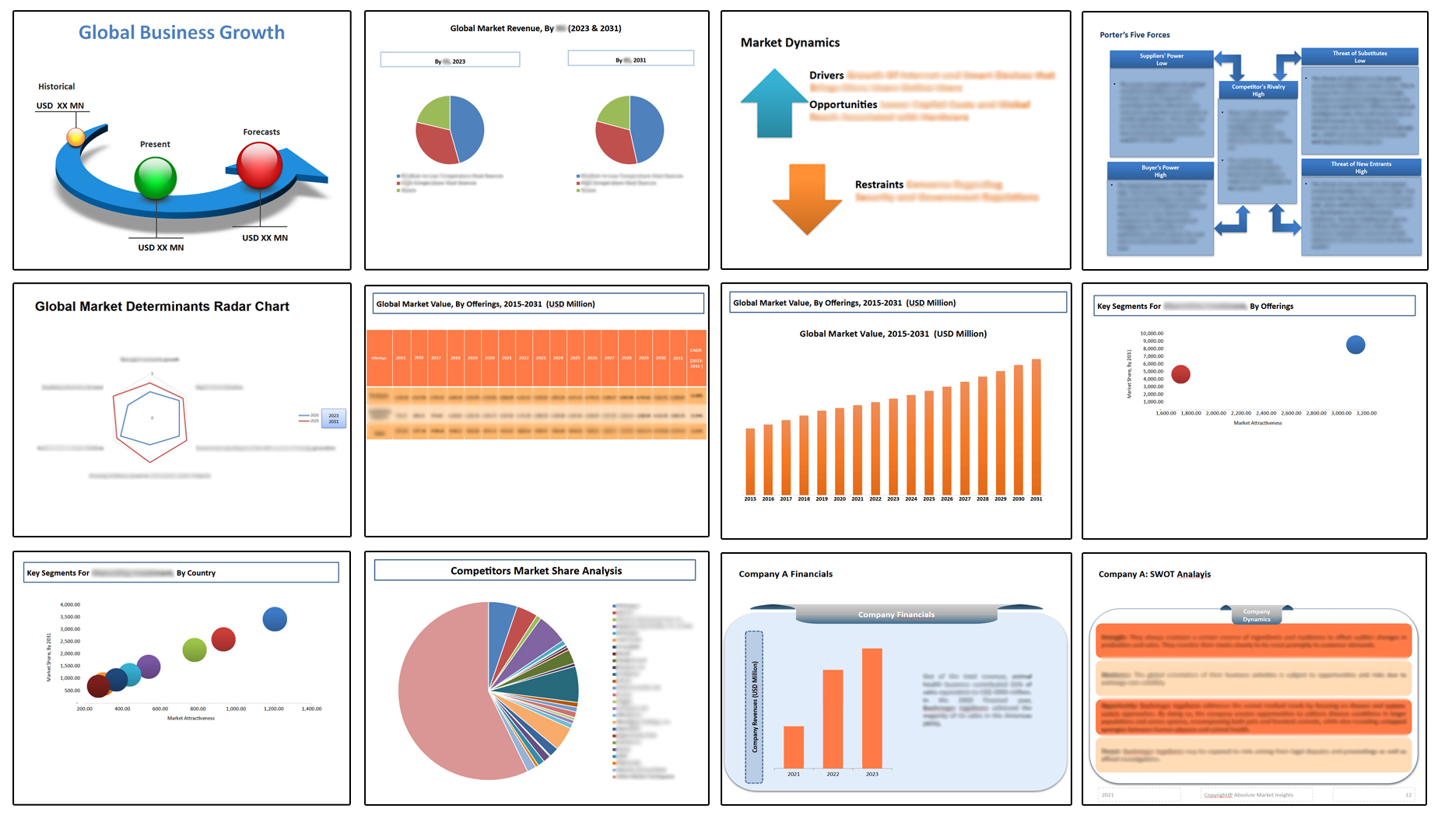
Table of Contents
Note: This ToC is tentative and can be changed according to the research study conducted during the course of report completion.
**Exclusive for Multi-User and Enterprise User.
Global Natural Language Processing Market
By Offering
- Software/Solution
- Services
- Training and Consulting
- Implementation and Maintenance
- Design and Development
- Others
By Deployment
- On-Premises
- Cloud
By Application
- Tokenization
- Sentiment Analysis
- Machine Translation
- Speech Recognition
- Pragmatic Analysis
- Keyword Extraction
- Others
By Organization Size
- Large Enterprises
- Small and Medium-sized Enterprises (SMEs)
By End Use Industry
- Education and Training
- Healthcare and Pharmaceutical
- Manufacturing and Automotive
- Banking, Financial Services and Insurance
- IT and Telecom
- Media and Entertainment
- Marketing and Advertising
- Travel and Hospitality
- Energy and Utilities
- Aerospace and Defense
- Transportation and Logistics
- Retail and Consumer Goods
- Government
- Others
By Region
- North America (U.S., Canada, Mexico, Rest of North America)
- Europe (France, The UK, Spain, Germany, Italy, Nordic Countries (Denmark, Finland, Iceland, Sweden, Norway), Benelux Union (Belgium, The Netherlands, Luxembourg), Rest of Europe)
- Asia Pacific (China, Japan, India, New Zealand, Australia, South Korea, Southeast Asia (Indonesia, Thailand, Malaysia, Singapore, Rest of Southeast Asia), Rest of Asia Pacific)
- Middle East & Africa (Saudi Arabia, UAE, Egypt, Kuwait, South Africa, Rest of Middle East & Africa)
- Latin America (Brazil, Argentina, Rest of Latin America)
The Niche Research approach encompasses both primary and secondary research methods to provide comprehensive insights. While primary research is the cornerstone of our studies, we also incorporate secondary research sources such as company annual reports, premium industry databases, press releases, industry journals, and white papers.
Within our primary research, we actively engage with various industry stakeholders, conducting paid interviews and surveys. Our meticulous analysis extends to every market participant in major countries, allowing us to thoroughly examine their portfolios, calculate market shares, and segment revenues.
Our data collection primarily focuses on individual countries within our research scope, enabling us to estimate regional market sizes. Typically, we employ a bottom-up approach, meticulously tracking trends in different countries. We analyze growth drivers, constraints, technological innovations, and opportunities for each country, ultimately arriving at regional figures.Our process begins by examining the growth prospects of each country. Building upon these insights, we project growth and trends for the entire region. Finally, we utilize our proprietary model to refine estimations and forecasts.
Our data validation standards are integral to ensuring the reliability and accuracy of our research findings. Here’s a breakdown of our data validation processes and the stakeholders we engage with during our primary research:
- Supply Side Analysis: We initiate a supply side analysis by directly contacting market participants, through telephonic interviews and questionnaires containing both open-ended and close-ended questions. We gather information on their portfolios, segment revenues, developments, and growth strategies.
- Demand Side Analysis: To gain insights into adoption trends and consumer preferences, we reach out to target customers and users (non-vendors). This information forms a vital part of the qualitative analysis section of our reports, covering market dynamics, adoption trends, consumer behavior, spending patterns, and other related aspects.
- Consultant Insights: We tap into the expertise of our partner consultants from around the world to obtain their unique viewpoints and perspectives. Their insights contribute to a well-rounded understanding of the markets under investigation.
- In-House Validation: To ensure data accuracy and reliability, we conduct cross-validation of data points and information through our in-house team of consultants and utilize advanced data modeling tools for thorough verification.
The forecasts we provide are based on a comprehensive assessment of various factors, including:
- Market Trends and Past Performance (Last Five Years): We accurately analyze market trends and performance data from preceding five years to identify historical patterns and understand the market’s evolution.
- Historical Performance and Growth of Market Participants: We assess the historical performance and growth trajectories of key market participants. This analysis provides insights into the competitive landscape and individual company strategies.
- Market Determinants Impact Analysis (Next Eight Years): We conduct a rigorous analysis of the factors that are projected to influence the market over the next eight years. This includes assessing both internal and external determinants that can shape market dynamics.
- Drivers and Challenges for the Forecast Period:Identify the factors expected to drive market growth during the forecast period, as well as the challenges that the industry may face. This analysis aids in deriving an accurate growth rate projection.
- New Acquisitions, Collaborations, or Partnerships: We keep a close watch on any new acquisitions, collaborations, or partnerships within the industry. These developments can have a significant impact on market dynamics and competitiveness.
- Macro and Micro Factors Analysis:A thorough examination of both macro-level factors (e.g., economic trends, regulatory changes) and micro-level factors (e.g., technological advancements, consumer preferences) that may influence the market during the forecast period.
- End-User Sentiment Analysis: To understand the market from the end-user perspective, we conduct sentiment analysis. This involves assessing the sentiment, preferences, and feedback of the end-users, which can provide valuable insights into market trends.
- Perspective of Primary Participants: Insights gathered directly from primary research participants play a crucial role in shaping our forecasts. Their perspectives and experiences provide valuable qualitative data.
- Year-on-Year Growth Trend: We utilize a year-on-year growth trend based on historical market growth and expected future trends. This helps in formulating our growth projections, aligning them with the market’s historical performance.
Research process adopted by TNR involves multiple stages, including data collection, validation, quality checks, and presentation. It’s crucial that the data and information we provide add value to your existing market understanding and expertise. We have also established partnerships with business consulting, research, and survey organizations across regions and globally to collaborate on regional analysis and data validation, ensuring the highest level of accuracy and reliability in our reports.









